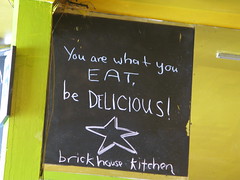When it comes to understanding the impact of digital media on the way we live our lives, there are few who dig as deeply as Michael Wesch. This is a recording of his speech at the US Library of Congress in June. And while the presentation starts off with some impressive statistics about the number of videos uploaded to YouTube (9,232 hours per day — 88% of which is original), the fascinating aspect of this presentation is the focus on story. In his own words:
… that is the story of the numbers and this is really a story about new forms of expression and new forms of community and new forms of identity emerging.
For the following 45 minutes or so, Michael Wesch leads us through a discussion on the way in which digital media is celebrating and connecting people in entirely new forms of shared experience. He starts with Numa Numa and his famous The Machine is Us/ing Us. Interestingly, the latter was initially launched the Wednesday before Superbowl Sunday — and as he had quickly reached an audience of over 200 people he sent a screen shot to the head of school for his permanent record. By Saturday the audience had grown to over 1100 viewings and the video had been posted on Digg. As you probably know, this video has at current count, around 5 million views.
As an anthropologist, Michael Wesch is providing a fascinating analysis of the shifts in society and culture that are already underway. In this video he shows how user generated content + user generated filtering + user generated distribution is reinventing the way in which we create, find and share branded and unbranded material via the web. This potent mix is ignited with a final piece, which Michael calls "user generated commentary" — ie blogs — however, I feel this is better represented as user generated CONTEXT. When blog authors share content with their readers, they create a context into which the content becomes more accessible and digestible for their particular audience. It is this final piece which is an essential part of any digital strategy. I fully recommend setting aside an hour to watch this presentation through, however, if you have limited time, I have written my thoughts below.
About 12 minutes into the presentation, Michael turns his attention to the media. Here he talks about the media not as technology but as a system through which human relations are mediated. This is given more context by showcasing the way that remixing and remastering videos allows others to participate in a video meme (eg Charlie Bit My Finger and its 100+ responses). Clearly this is not just about claiming 15 seconds of fame. This type of participation goes to the very heart of the P-L-A-Y (P-ower, L-earning, A-dventure, Y-elp of surprise), delivering an experience that crosses the chasm that is imposed upon us by culture, geography, suburbia and even the isolating experience of TV viewing.
But the experience of this is dislocating. At 23 minutes, Michael explains "context collapse" which is what happens when we first begin to "participate". For example, think back to the first time that you wrote a blog post, think about your first comment on another’s blog. By participating in this way, you release your thoughts into an environment in which you have no context. You don’t know how it will be read or understood, nor where or when. You don’t even necessarily "know" your reader. Now, apply this same thinking to video. You are "speaking" or "presenting" to a small webcam, not a person. Well, not yet anyway. The human interaction is delayed, mediated, spread across time and space. It takes time for "participants" to become used to this new mode of delayed being. It is, perhaps, why the easiest way to understand blogging is to participate.
At around the thirty minute point, Michael walks us through the topic of cultural inversion. This describes the tension that we (in a cultural sense) experience as participants. On the one hand we express individualism, independence and a keen commercialism while desiring community and relationships within an authentic context. YouTube, and to a certain extent, other social media, allow us to experience this tension as a deep connection with others without the responsibility that comes with close, personal relations. It strikes me that by adding a third party into this equation, for example, a "good cause" like a charity, you are able to move quickly from this state of mediated connection to "community actualisation" (thinkng a community version of maslow’s hierarchy of needs).
But what happens when this is "gamed"? Michael explores YouTube’s authenticity crisis about 36 minutes in, using EmoKid21Ohio and LonelyGirl15 as examples. Ten minutes later the topic of copyright is broached (any remixing is basically illegal). Using a clip from Lawrence Lessig’s TED talk, the challenge is contextualised — the culture has moved on and the law is struggling to recontextualise its own relevance:
You can’t kill the instant the technology produces, we can only criminalize it. We can’t stop our kids from using it, we can only drive it underground. We can’t make our kids passive again, we can only make them "pirates" … and is that good?
We live in … an age of prohibitions where many areas of our life, we live life constantly against the law, ordinary people live life against the law … and that realization is extraordinarily corrosive, extraordinarily corrupting, and in a democracy we ought to be able to do better.
The presentation is wrapped up by video quoting bnessel1973:
Some people say that the videos we create on YouTube should be created in hopes to change the world. I have made mine to help me live in it.

